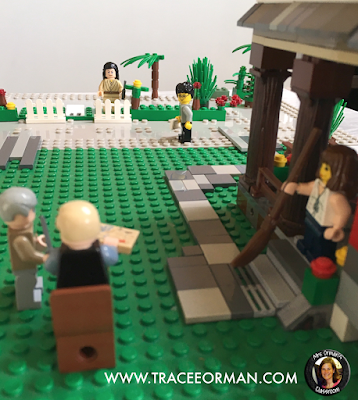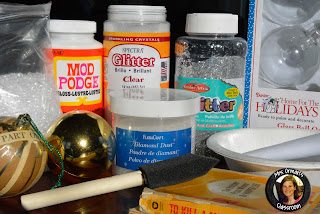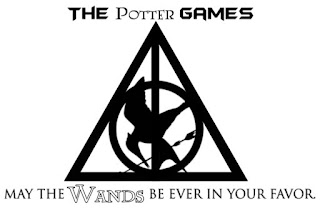Several years ago a group of boys approached me and asked if they could recreate scenes from the book To Kill a Mockingbird by Harper Lee using LEGO™building blocks for their culminating project. This option was not on my original list of projects.
After determining that they were serious (and not just trying to get out of doing actual work), I caved and let them. And what I observed during the process was unexpected and simply marvelous. While I hoped The boys were constantly referring back to the novel to try to get the details correct. One argument was what color was Atticus's hair. They searched and searched until they found the passage in chapter 15 where Scout contrasts Jem's features with "...Atticus's graying black hair..." (Lee 203). Then they had the problem of not having black or gray hair. One boy suggested to just put a hat on him. "Atticus would never wear a hat!" another argued. I have to admit I enjoyed listening to them argue about these little details, referring back to the text, and deciding how to resolve these problems. (They went with blond for Atticus--see in the image above--making sure to tell me it was supposed to be gray.)
Above, Mr. Avery falling off Miss Maudie's roof in chapter 8 of To Kill a Mockingbird.
What I realized, though, was that this was not only a lesson in finding supporting evidence from the text, but a lesson in negotiating, communicating, and compromising with one another. And let's not forget the creativity involved. A year later when I tried this with small groups, we had the dilemma of having "people" who just didn't seem to work with our novel:
The way the students adapted the figures into the story was priceless:
Student A: Mrs. Orman, where are Spongebob's legs?
Me: I have no idea. Gone, I guess.
Student B: Well, he'll have to be Dill. You know, because he's so short.
Student A: And blond.
Student B: Perfect.
* * *
Student C: Darth Vader is obviously Bob Ewell.
Student D: Obviously.
Student C: So who will Boo be?
Student D: Are you kidding? Boo is a Ninja. He was always a Ninja. I can't believe we are having this conversation.
* * *
Student E: Why is Tom a Stormtrooper?
Student F: Because his face is black.
Student E: That is so racist.
Student F: How is that racist when it's just a fact?
Student E: Because you are white, Dude. You can't say things like that. And because we have this thing here missing an arm. That's clearly Tom.
Student F: Now who's being racist?!
Student E: Dude, that's not racist.
Student G (from another group, yelling across the room): There's more to people than just their looks, Guys!
Student E: Ok, well Stormtroopers are evil and Tom's the innocent one here.
Student F: What about Finn? He's good and he was a Stormtrooper.
Student E: But Tom didn't start evil and turn good. Tom was always a good man.
Student F: Fine. Tom will be the brown robot with one arm. But what if this thing is just as bad as a Stormtrooper? We know nothing about this robot.
Student E: He was a caring robot who lived his life helping others. I already created a whole backstory for him...
* * *
I actually prefer using figures who may not fit the mold in order to push students to think more critically and creatively about the characters.
"Boo is a Ninja. He was always a Ninja..."
PREPARING FOR THE ACTIVITY
Before trying this in class, make sure you are prepared with enough building blocks for students (this was the first challenge the group faced). One boy in the group brought in a small box that they thought would be sufficient; unfortunately, the pieces were designed to build vehicles rather than structures. The next day they brought in a five-gallon tub full, which was more than sufficient.
Below is an example of how many blocks it may take to build a simple scene outside a jail cell. Keep in mind that the structures do not have to be complete (only two sides of this jail cell are finished):
Here are some other examples requiring a few more blocks:
IMPLEMENTING THE ACTIVITY IN THE CLASSROOM
You'll want to determine the skills you wish students to practice. The more you ask of them, the longer they will need to practice them.
GROUP PROJECT:
The skills I wanted students to practice with the group project (2-3 class periods) included inferring and interpreting scenes from the novel and creating a visual representation of the inferences. I also wanted them to communicate in writing a summary of the project.
I required the group of four boys to show me four different scenes from the book and explain (both orally and in writing) why they chose the scenes, which details they wanted to make sure they included in each, why those details were important, and the problems they encountered and how they resolved them within the group. Each member took on the responsibility for writing about one of the scenes but, for the most part, they all had a hand in building all four scenes. The group had three class periods to complete the project.
END-OF-THE-CHAPTER or EXIT ACTIVITY:
For a shorter activity (10-20 minutes), the skills I wanted students to practice were similar: inferring and interpreting scenes from the chapter and creating a visual representation based on the inferences.
Students split into small groups and each group got a little pile of blocks (enough to build at least one or two walls) and two figures. I asked each group to select a scene to reenact from the chapter we had just completed reading in class. If they wanted more blocks, they had to answer a question from the novel (from any of the previous chapters) to earn more blocks or props. Some students negotiated with students from other groups to trade blocks, which was fine with me. At the end of the period, I did not allow them to save their work because I had to reuse the blocks for the next class period. I recommend taking pictures of them, though, that you can display after every class period/section has completed the exercise.
If you wish to incorporate the writing component, you could use it as a bell-ringer the following day. Ask students to reflect on the previous day's activity and write why they chose the scene, which details they made sure to include, and problems they may have faced and how their group rectified them.
CREATIVE ACTIVITIES FOR ANY BOOK
If you like this idea, I have plenty more in my pack: Creative Activities for ANY Book or Story. They are all aligned with the Common Core State Standards, so you don't have to feel guilty for incorporating more creativity into your classroom.
The following pictures are additional examples from To Kill a Mockingbird. Can you identify the scene?
* The scene depicted is from chapter 4 when the children are acting out the "Boo Radley" game. It's a combination of when Miss Maudie sees them--the screwdriver is her hedge clippers--and when the children are acting out "Chapter XXV, Book II of One Man's Family" and Atticus sees them (Lee 53).
Work cited:
Lee, Harper. To Kill a Mockingbird. 1960. Hachette Book Group, 2010.
















































